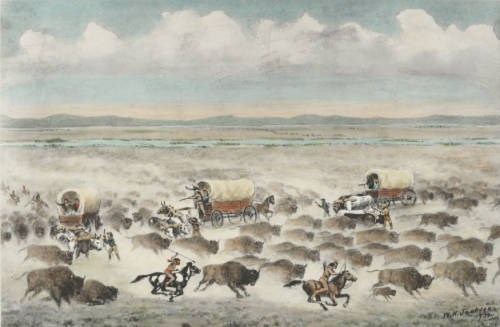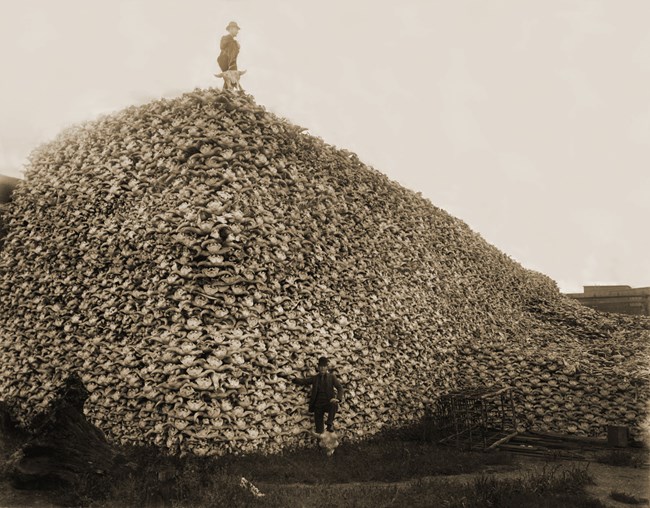Part of a series of articles titled The Emigrant Experience .
Previous: The Platte Experience
Next: Women Traveling West
Article

Image/Courtesy Denver Public Library
Emigrants heading west along the Platte River overland trail corridor in the early years of the overland emigration wrote excitedly in diaries and journals about their first sightings of buffalo and the wild hunts that typically followed. Some wagon trains got caught in buffalo stampedes, and some lost cattle that ran off to join the unimaginably enormous herds of wild bison. But as commercial hunters and sport-slaughter systematically thinned those herds throughout the emigration era, that part of the overland experience changed.
The family of the Ref. Edward Evans Parrish jumped off onto the Oregon Trail at St. Joseph, Missouri, in 1844, as part of 323-member wagon train that later split into smaller groups. This train, among the earliest to go overland to Oregon, cut northwest across Kansas—buffalo already were hunted out of eastern Kansas by then— to join the Platte River trail corridor in the vicinity of Grand Island, Nebraska. Four days’ travel west of there, the company approached it’s first big buffalo herd and stopped to hunt.
“[Buffalo] are found here in vast quantities,” Parrish wrote in his July 11 journal entry. “All who could raise a horse and gun, were after them; fourteen were killed. It is difficult to form an estimate of the numbers to be seen at a look.” The bison, he observed, were “thicker than…stars in the firmament.”
The 14 slain buffalo were partially butchered and left on the plains for processing the next morning, but all of the meat spoiled in the heat. “God forgive us for such waste and save us from such ignorance,” wrote Parrish. He described the hunt this way:
Buffalo racing is a business of much diversion, indeed. A horse of common speed will run upon them immediately. The hunter then dismounts and fires, then loads and mounts again, and soon comes within gunshot. This process is continued until he has taken all he wants.
As the wagon train continued west, hunters continued to kill a few bison each day. At least once, women from the wagon train joined the hunt. Although chasing the buffalo could be dangerous, emigrants regarded the hunt as an exciting sport.
On July 19, Parrish recorded that “Buffalo are seldom out of sight of the wagons. The next day he noted “numerous herds of buffalo” along on the south side of the South Fork of the Platte River, adding, “An attempt at description would appear in the character of a romance.”
On July 22 his wagon party stopped in the vicinity of Ash Hollow to hunt and cure buffalo meat, “as it is thought we will get no more.” They did, though: Parrish recorded the final hunt on Aug. 13, two days east of the Sweetwater River, which lies west of Casper in present-day Wyoming. “Well,” he concluded, “we have had a fine run of [buffalo] for four or five hundred miles.

But compare the Parrish family’s 1844 overland experience to the 1866 trip of the Stewart B. Eakins family, with three members who kept journals along the way. The Eakins party jumped off onto the Oregon Trail from Omaha, Nebraska, and so would have driven along the north side of the Platte, whereas the Parrish wagon train would have traveled along the south side much of the way. It was the same wagon corridor, though, and they should have shared similar experiences with regard to bison encounters. However, none of the three Eakins family writers mentioned buffalo — not one sighting.
Something, clearly related to the wagon traffic and the new transcontinental railroad under construction along the same corridor west from Omaha, had created a 50-mile wide gap in bison distribution, with the trail as a center line. Emigrants shot the shaggy animals for meat and for entertainment, but hunters contracted by the Union Pacific Railroad—Buffalo Bill was one of these—to feed its ravenous construction crews also took a considerable toll on the buffalo, helping to split them into a Northern and a Southern herd. Hide hunting, railroad sharpshooters trying to clear the tracks, and recreational slaughter by train passengers firing out the windows of their rail cars began in earnest around 1870, just a year after completion of the transcontinental railroad. By 1883, nearly all the bison in the United States were gone, their hides shipped to Europe or used to make inexpensive harness and heavy-duty belts for industrial machines in the East. By 1884, only around 325 wild bison remained in the US.
All that was left of the big herds was their bones, which collectors soon gathered into huge piles to be sold for use in the process of refining sugar and the manufacture of fertilizer and bone china.
Dary, David. 1975. The Buffalo Book. Avon, New York.
Ewart, S., J. Anderson, and J. Anderson. 1993. A Long and wearisome journey: The Eakin family diaries, 1866. Pike Press, Enterprise, Or.
Parrish, Edward Evans, and Bert Webber. 1988. The Oregon Trail diary of Rev. Edward Evans Parrish in 1844: the unabridged diary. Webb Research Group, Medford, Or.
Roe, Frank Gilbert. 1972. The North American Buffalo: A critical study of the species in its wild state. David & Charles, Newton Abbot.
Rorabacher, J. Albert. 1971. The American buffalo in transition: a historical and economic survey of the bison in America. North Star Press, Saint Cloud, Minn.
Part of a series of articles titled The Emigrant Experience .
Previous: The Platte Experience
Next: Women Traveling West
Last updated: December 20, 2020